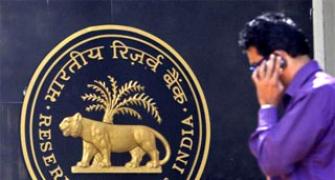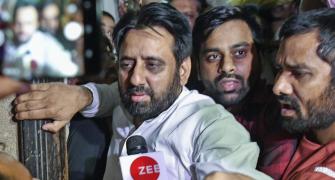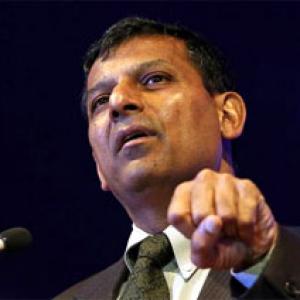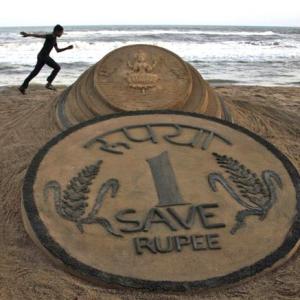Monetary easing would carry very few risks now, and offer several large benefits, says Andy Mukherjee.

Global disinflation has finally caught up with India's high-cost economy.
Rapidly easing price pressures are creating room for the Reserve Bank of India (RBI) to follow its counterpart in Beijing and start cutting interest rates.
Monetary easing would carry very few risks now, and offer several large benefits.
The Chinese central bank surprised investors on November 21 by cutting one-year lending rates by 40 basis points to 5.6 per cent, and by lowering the deposit rate by 25 basis points to 2.75 per cent.
China's first reduction in borrowing costs since 2012 was an attempt to ward off deflation. Sliding producer prices are pushing up the real, or inflation-adjusted, value of China's alarmingly large corporate debt burden. Lower rates will give borrowers some relief.
Nevertheless, reducing borrowing costs is a gamble for the People's Republic, which is already suffering from significant overcapacity in industries like property and steel. A fresh credit binge could store up trouble for the future by making eventual corporate deleveraging much worse.
India doesn't face quite the same danger. The country is short of investment in everything from coal and power to roads and housing.
And if China has too much debt, India has too little. Total credit in the private non-financial sector was the equivalent of about 50 per cent of gross domestic product (GDP) in March this year, compared with 175 per cent in China. Consequently, the Indian economy is burdened by severe capacity constraints, which make it vulnerable to high inflation and large trade deficits.
One such period of double-digit inflation has only recently ended. Consumer prices in India are now rising at a subdued 5.5 per cent pace, well within the central bank's six per cent target for January 2016.
Even then, most bankers and economists believe RBI Governor Raghuram Rajan will wait until at least the second quarter of 2015 before he lowers the benchmark repo rate, currently at eight per cent.
But that timetable may need to be brought forward for a number of reasons.
For one, the exchange rates of commodity-producing countries like Australia, New Zealand, South Africa, Canada and Chile are still weakening.
And these are usually a reliable predictor of commodity prices, which are down 20 per cent since end-June.
The carnage may be far from over. India might witness even faster disinflation if Iran and global powers manage to thrash out a much-awaited nuclear agreement by the new deadline of July 1.
Any deal to end sanctions against Iran's oil exports could prompt global energy prices to extend their slide. That would help oil-importing economies like India keep their fuel costs down.
Meanwhile, both the Indian government and the private sector badly want the RBI to lower borrowing costs.
And their demand is hardly unreasonable. Prime Minister Narendra Modi is seeking investment from around the world. He wants to turn the country into a manufacturing hub.
Yet industrial production is reviving at a frustratingly slow pace, credit demand is faltering and tax collections are weak. High borrowing costs are not the main reason why investment in factories, machines and other fixed assets has all but dried up.
A far bigger culprit is the steady deterioration in the country's business climate that occurred under the previous government. But all that is in the past.
From here on, sacrificing output unnecessarily in the absence of price pressures will do nothing to burnish Dr Rajan's already-strong credentials as an inflation hawk.
Nor will it help Finance Minister Arun Jaitley realise his target of reducing the fiscal deficit by boosting GDP growth and tax revenue.
As the euro zone's experience shows, fiscal rectitude is counterproductive in an economy mired in a prolonged slump.
It's unlikely that lower interest rates would cause a destabilising capital flight. During the "taper scare" of mid-2013, India was running a very high trade deficit.
Investors suddenly baulked at financing it, causing the overvalued rupee to stumble and forcing the RBI to raise interest rates to stem capital outflows. Since then, though, India's current-account deficit has narrowed remarkably, and the rupee is no longer overvalued.
Besides, with global disinflation rearing its head, the prospect of an early end to the cheap money era in rich nations - and an abrupt increase in their cost of capital - has receded.
For India, losing access to dollar financing is a far smaller worry now than in the summer of last year.
The risk of upsetting domestic savers is perhaps the only reason why the RBI may hesitate to cut rates.
Households' one-year-ahead inflation expectations are still stuck in double digits, according to the central bank's surveys.
While those expectations could turn out to be unduly pessimistic, they could nonetheless determine savers' behaviour in the short term.
That would be worrisome for the monetary authority.
Deposit growth in the banking system, which has collapsed in recent years because of high inflation, is languishing at a four-decade low.
If savers end up viewing a rate cut as a breach of the central bank's commitment to lower inflation, they might once again rush to preserve their wealth in gold.
That could scuttle a revival in productive investment. But this gloomy prognosis doesn't square with improving investor sentiment.
The benchmark Nifty equity index has risen 36 per cent so far this year, and could receive a further boost once the RBI starts easing rates.
Higher equity prices will, in turn, allow the government to speed up asset sales. Fiscal consolidation will get a boost.
The next monetary policy announcement is due on December 2. A symbolic rate cut would carry little danger of the RBI losing the plot on inflation or financial stability.
But coming close on the heels of the easing move in China, it will whet investor appetite for deeper reductions.
While its northern neighbour needs to keep existing debtors afloat, India needs new borrowers to start queuing up for loans. The challenges may be starkly different, but the solution is now the same for both.
(Andy Mukherjee is the Asia economics columnist at Reuters Breakingviews in Singapore. These views are his own)










